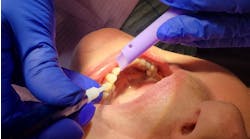By JoAnn Gurenlian, RDH, PhD
Most health care workers understand that human papillomavirus (HPV) is a sexually transmitted virus that has been associated with cervical cancer. Genital infection with high-risk HPV types may also be responsible for the development of vulvular, vaginal, anal and penile carcinomas.(1) Within the last decade, studies have been examining the association between HPV and head and neck squamous cell carcinomas (HNSCC). Accumulating molecular and pathologic studies have strengthened the understanding that HPV plays a role in the etiology of some oropharyngeal carcinomas.(2-4)
Most health care workers understand that human papillomavirus (HPV) is a sexually transmitted virus that has been associated with cervical cancer. Genital infection with high-risk HPV types may also be responsible for the development of vulvular, vaginal, anal and penile carcinomas.(1) Within the last decade, studies have been examining the association between HPV and head and neck squamous cell carcinomas (HNSCC). Accumulating molecular and pathologic studies have strengthened the understanding that HPV plays a role in the etiology of some oropharyngeal carcinomas.(2-4)
There are over 130 types of HPV, many of which are of little consequence to the health of the public. However, some types of HPV, particularly HPV 6 and 11, have been associated with genital warts and condyloma, while HPV 16 and 18 are considered high risk types and are implicated in the development of cervical cancer. With respect to the oral cavity, HPV16 DNA has been found in oral cancer of the oral cavity and oropharynx, primarily in the tonsillar region and base of the tongue.(2,3,5) Other HPV types implicated in oropharyngeal cancers to a lesser extent include 6, 18, 31, 33, 35, 45, and 52/58.(6,7)The mechanism of pathogenesis of high risk HPVs appears to be through the promotion of tumorigenesis through expression of the E6 and E7 oncoproteins. These proteins inactivate tumor suppressors TP53 and RB1.(8-10)Common etiologies for oral cancer include tobacco and alcohol, with oral cancer occurring more frequently during middle age and later. With HPV related HNSCC, lesions occur more frequently in a younger group of individuals, who are nonsmokers and nondrinkers,(11-16) and have been associated with lymph node metastasis.(6) However, the survival rate for those with HPV positive tumors is better when compared with tobacco induced SCC as HPV positive tumors appear to be more susceptible to radiation treatments.(4,12,17,18) Further study is needed to explain this phenomenon.In considering the growing concern about the extent of HPV infection and its effects on the oropharyngeal area, dental hygienists and dentists must consider taking greater action with respect to prevention and patient education. Identifying those who are sexually active is a first step. Early onset of intercourse, including oral sex, and use of multiple partners should be assessed. Those individuals need to understand their risk increases for HPV infection of genital and oropharynx regions. They should be counseled to have regular physical examinations with a family practitioner and/or gynecologist, have the HPV vaccine (both for boys and girls), and have oral cancer examinations performed at all dental and dental hygiene appointments.
A new test has been developed that identifies HPV in the oral cavity (OraRisk HPV at OralDNA Labs) and should be considered for incorporation as part of oral health care for those at high risk for HPV infection.References
1. zur Hausen H. Papillomavirus infections – a major cause of human cancers. Biochim Biophys Acta 1996;1288:F55-78.2. Schwartz, SM, Daling JR, Doody DR, Wipf GC. Oral cancer risk in relation to sexual history and evidence of human papillomavirus infection. J Natl Cancer Inst 1998;90(21):1626-1636.3. Herrero R, Castellsagué X, Pawlita M, Lissowska J, et al. Human papillomavirus and oral cancer: the international agency for research on cancer multicenter study. J Natl Cancer Inst 2003;95(23):1772-1783.4. The HPV Connection- the human papillomavirus related to oral cancer. Oral Cancer Foundation. Available at oralcancerfoundation.org. Accessed 4/12/11.5. D’Souza G, Freimer AR, Viscidi R, Pawlita M, et al. Case-control study of human papillomavirus and oropharyngeal cancer. N Engl J Med 2007;356:1944-1956.6. Machado J, Reis PP, Zhang T, Simpson C, et al. Low prevalence of human papillomavirus in oral cavity carcinomas. Head &Neck Oncology 2010. 2:6. 7. Gillison ML, Shah KV. Role of mucosal human papillomavirus in nongenital cancers. J Natl Cancer Inst Monograph Chapter 9. 2003;(31): 57-65.8. Nair S, PIllai MR. Human papillomavirus and disease mechanisms: relevance to oral and cervical cancers. Oral Dis 2005; 11:350-359.9. Munger K, Howley PM. Human papillomavirus immortalization and transformation functions. Virus Res 2002;89:213-228.10. Rampias T, Sasaki C, Weinberger P, Psyrri A. E6 and E7 gene silencing and transformed phenotype of human papillomavirus 16-positive oropharyngeal cancer cells. J Natl Cancer Inst 2009;101:412-423.11. Fakhry C and Gillison ML. Clinical implications of human papillomavirus in head and neck cancers. J Clin Oncol 2006;24:2606-2611.12. Gillison ML, Koch WM, Cpaone RB, Spafford M, et al. Evidence for a casual association between human papillomavirus and a subset of head and neck cancers. J Natl Cancer Inst 2000;92:709-20.13. Mellin H, Friesland S, Lewensohn R, Dalianis T, et al. Human papillomavirus (HPV) in tonsillar cancer: clinical correlates, risk of relapse, and survival. Int J Cancer 2000;89:300-304.14. Dahlstrand HM, Dalianis, T. Presence and influence of human papillomavirus (HPV) in tonsillar cancer. Adv Cancer Res 2005;93:59-89.15. Lindquist D, Romanitan M, Hammarstedt L, Nasman A, et al. Human papillomavirus is a favourable prognostic factor in tonsillar cancer and its oncogenic role is supported by the expression of E6 and E7. Mol Oncol 2007;1:350-355.16. Marur S, D’Souza G, Westra WH, Forastierre AA. HPV-associated head and neck cancer: a virus related cancer epidemic. Lancet Oncol 2010;11:781-789.17. Torbjörn R, Dalianis T. Oropharyngeal cancer epidemic and human papillomavirus. Emerg Infect Dis [serial on the interenet]. 2010 Nove. www.cdc.gov/EID/content/16/11/1671.htm. Accessed 4/12/11.18. Ang KK, Harris J, Wheeler R, Weber R, et al. Human papillomavirus and survival of patients with oropharyngeal cancer. N Engl J Med 2010;1-12 available at NEJM. Org. Accessed 4/12/11.
1. zur Hausen H. Papillomavirus infections – a major cause of human cancers. Biochim Biophys Acta 1996;1288:F55-78.2. Schwartz, SM, Daling JR, Doody DR, Wipf GC. Oral cancer risk in relation to sexual history and evidence of human papillomavirus infection. J Natl Cancer Inst 1998;90(21):1626-1636.3. Herrero R, Castellsagué X, Pawlita M, Lissowska J, et al. Human papillomavirus and oral cancer: the international agency for research on cancer multicenter study. J Natl Cancer Inst 2003;95(23):1772-1783.4. The HPV Connection- the human papillomavirus related to oral cancer. Oral Cancer Foundation. Available at oralcancerfoundation.org. Accessed 4/12/11.5. D’Souza G, Freimer AR, Viscidi R, Pawlita M, et al. Case-control study of human papillomavirus and oropharyngeal cancer. N Engl J Med 2007;356:1944-1956.6. Machado J, Reis PP, Zhang T, Simpson C, et al. Low prevalence of human papillomavirus in oral cavity carcinomas. Head &Neck Oncology 2010. 2:6. 7. Gillison ML, Shah KV. Role of mucosal human papillomavirus in nongenital cancers. J Natl Cancer Inst Monograph Chapter 9. 2003;(31): 57-65.8. Nair S, PIllai MR. Human papillomavirus and disease mechanisms: relevance to oral and cervical cancers. Oral Dis 2005; 11:350-359.9. Munger K, Howley PM. Human papillomavirus immortalization and transformation functions. Virus Res 2002;89:213-228.10. Rampias T, Sasaki C, Weinberger P, Psyrri A. E6 and E7 gene silencing and transformed phenotype of human papillomavirus 16-positive oropharyngeal cancer cells. J Natl Cancer Inst 2009;101:412-423.11. Fakhry C and Gillison ML. Clinical implications of human papillomavirus in head and neck cancers. J Clin Oncol 2006;24:2606-2611.12. Gillison ML, Koch WM, Cpaone RB, Spafford M, et al. Evidence for a casual association between human papillomavirus and a subset of head and neck cancers. J Natl Cancer Inst 2000;92:709-20.13. Mellin H, Friesland S, Lewensohn R, Dalianis T, et al. Human papillomavirus (HPV) in tonsillar cancer: clinical correlates, risk of relapse, and survival. Int J Cancer 2000;89:300-304.14. Dahlstrand HM, Dalianis, T. Presence and influence of human papillomavirus (HPV) in tonsillar cancer. Adv Cancer Res 2005;93:59-89.15. Lindquist D, Romanitan M, Hammarstedt L, Nasman A, et al. Human papillomavirus is a favourable prognostic factor in tonsillar cancer and its oncogenic role is supported by the expression of E6 and E7. Mol Oncol 2007;1:350-355.16. Marur S, D’Souza G, Westra WH, Forastierre AA. HPV-associated head and neck cancer: a virus related cancer epidemic. Lancet Oncol 2010;11:781-789.17. Torbjörn R, Dalianis T. Oropharyngeal cancer epidemic and human papillomavirus. Emerg Infect Dis [serial on the interenet]. 2010 Nove. www.cdc.gov/EID/content/16/11/1671.htm. Accessed 4/12/11.18. Ang KK, Harris J, Wheeler R, Weber R, et al. Human papillomavirus and survival of patients with oropharyngeal cancer. N Engl J Med 2010;1-12 available at NEJM. Org. Accessed 4/12/11.
JoAnn R. Gurenlian, RDH, PhD, is President, Gurenlian & Associates, and President-Elect, International Federation of Dental Hygienists.









